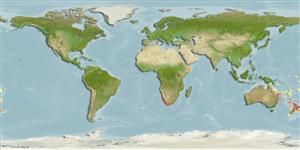Teleostei (teleosts) >
Ophidiiformes (Cusk eels) >
Carapidae (Pearlfishes) > Pyramodontinae
Etymology: Pyramodon: Greek, pyramis = pyramid + Greek, odous = teeth (Ref. 45335).
More on author: Regan.
Environment: milieu / climate zone / depth range / distribution range
Ecology
Marine; benthopelagic; depth range 120 - 731 m (Ref. 6347). Temperate
Indo-West Pacific: off East London, South Africa; Australia and New Zealand.
Size / Weight / Age
Maturity: Lm ? range ? - ? cm
Max length : 29.0 cm TL male/unsexed; (Ref. 4104)
Eel-like, moderate to relatively deep body depth; a large single vomerine fang; pelvic fin rays present; swim bladder large, filling visceral cavity and extending past anus; dorsal and anal fin radials robust and elongate; dorsal fin anteriad or directly over anal fin origin; lacking rockerbone, cardiform teeth, and intrinsic swim bladder constrictions or tunic ridges (Ref. 34024). Body lightly pigmented with dorsal and anal fin margins pigmented over posterior quarter; precaudal vertebrae 17-19; anus more posterior with distance from snout to anus 130 to 151% head length (Ref. 34024).
A benthic (Ref. 75154) and rare species (Ref. 34024). Probably a free-living species of the outer shelf and upper continental slope.
Life cycle and mating behavior
Maturity | Reproduction | Spawning | Eggs | Fecundity | Larvae
Nielsen, J.G., D.M. Cohen, D.F. Markle and C.R. Robins, 1999. Ophidiiform fishes of the world (Order Ophidiiformes). An annotated and illustrated catalogue of pearlfishes, cusk-eels, brotulas and other ophidiiform fishes known to date. FAO Fish. Synop. 125(18):178p. Rome: FAO. (Ref. 34024)
IUCN Red List Status (Ref. 130435: Version 2024-1)
Threat to humans
Harmless
Human uses
Fisheries: of no interest
Tools
Can't connect to MySQL database fbquizv2. Errorcode: Too many connections
